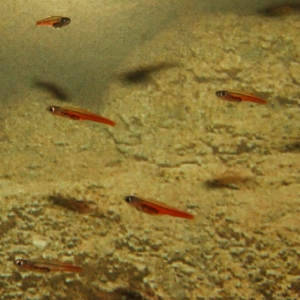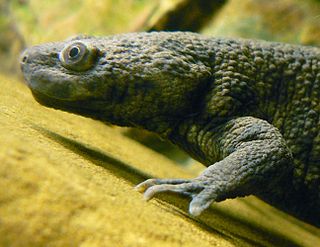
Cyprinidae is a family of freshwater fish commonly called the carp or minnow family, including the carps, the true minnows, and their relatives the barbs and barbels, among others. Cyprinidae is the largest and most diverse fish family, and the largest vertebrate animal family overall, with about 3,000 species; only 1,270 of these remain extant, divided into about 200 valid genera. Cyprinids range from about 12 mm (0.5 in) in size to the 3 m (9.8 ft) giant barb. By genus and species count, the family makes up more than two-thirds of the ostariophysian order Cypriniformes. The family name is derived from the Greek word kyprînos.

In botany, apomixis is asexual development of seed or embryo without fertilization. However, other definitions include replacement of the seed by a plantlet or replacement of the flower by bulbils.

Paedocypris is a genus of tiny cyprinid fish found in swamps and streams on the Southeast Asian islands of Borneo, Sumatra and Bintan.

The Iberian ribbed newt, gallipato or Spanish ribbed newt is a newt endemic to the central and southern Iberian Peninsula and Morocco. It is the largest European newt species and it is also known for its sharp ribs which can puncture through its sides, and as such is also called the sharp-ribbed newt.

The Japanese rice fish, also known as the medaka, is a member of genus Oryzias (ricefish), the only genus in the subfamily Oryziinae. This small native of Japan is a denizen of rice paddies, marshes, ponds, slow-moving streams and tide pools. It is euryhaline, occurring in both brackish and freshwater. It became popular as an aquarium fish because of its hardiness and pleasant coloration: its coloration varies from creamy-white to yellowish in the wild to white, creamy-yellow, or orange in aquarium-bred individuals. Bright yellow, red or green transgenic populations, similar to GloFish, have also been developed, but are banned from sale in the EU. The medaka has been a popular pet since the 17th century in Japan. After fertilization, the female carries her eggs attached anterior to the anal fin for a period before depositing them on plants or similar things.

Parthenogenesis is a natural form of asexual reproduction in which growth and development of an embryo occur directly from an egg, without need for fertilization. In animals, parthenogenesis means development of an embryo from an unfertilized egg cell. In plants, parthenogenesis is a component process of apomixis. In algae, parthenogenesis can mean the development of an embryo from either an individual sperm or an individual egg.

Anaecypris hispanica, the Spanish minnowcarp, is a small species of ray-finned fish species in the family Cyprinidae. It is the only living member of the genus Anaecypris. It is endemic to the Iberian Peninsula and is found in the basin of the Guadiana River in southern Spain and Portugal. Its natural habitats are rivers and intermittent rivers which are shallow, highly oxygenated, have a water temperature of no more than 25 °C and have a coarse stream bed. It is threatened by habitat loss. They grow to a maximum size of 60mm and live for three years.

The Northern straight-mouth nase is a species of ray-finned fish in the family Cyprinidae. It is found in Portugal and Spain. Its natural habitat is rivers. It is threatened by habitat loss.

The Iberian nase is a species of freshwater fish in the family Cyprinidae. It is found in Portugal and in Spain. Its natural habitats are rivers and intermittent rivers.

Parachondrostoma turiense is a species of ray-finned fish in the family Cyprinidae. It is found only in Spain. Its natural habitat is rivers. It is threatened by habitat loss.

Pseudochondrostoma willkommii is a species of cyprinid fish, which is found in Portugal and Spain. Its natural habitats are rivers and water storage areas, and it is threatened by habitat loss.
Squalius is a genus of fish in the family Cyprinidae found in Europe and Asia. Hybridization is not rare in the Cyprinidae, including this genus. S. alburnoides is known to be of ancient hybrid origin, with the paternal lineage deriving from a prehistoric species related to Anaecypris; the latter mated with ancestral S. pyrenaicus. Present-day S. alburnoides mates with sympatric congeners of other species.

Squalius carolitertii, the Northern Iberian chub, is a species of fresh-water fish in the family Cyprinidae. It is found in Portugal and Spain, and known there as the bordallo, escalo or gallego.

Squalius keadicus is a species of fresh-water fish in the family Cyprinidae. It is found only in Greece, and known as the menida in Greek.

Squalius svallize is a species of freshwater fish in the family Cyprinidae. It is found in Bosnia and Herzegovina and Croatia. Its natural habitats are rivers and inland karsts. It is threatened by habitat loss.

Squalius janae, commonly known as the Istrian chub, is a species of freshwater fish in the carp family Cyprinidae. It was first described in 2010 from the Dragonja River drainage in Slovenia. Since then they have also been found in the Boljunčica and Pazinčica river drainages in Istria, Croatia.

The Manyas spirlin is a species of minnow that is endemic to the Simav River drainage of Lake Kuş, also known as Lake Manyas, in Turkey. It may become threatened as its range is densely inhabited and increasingly industrialized.

Squalius valentinus, commonly known as the Valencia chub and the Levantine bagra, is a species of freshwater fish in the carp family Cyprinidae. It was first isolated from the Turia River in Valencia, hence its name. It is considered endangered. This species is differentiated from its cogenerates by having eight branched rays in its dorsal fin; eight branched rays in its anal fin; two rows of pharyngeal teeth on both sides possessing 2 and 5 teeth ; a wide caudal peduncle; its number of gill rakers; the number of scales in its lateral line; the number of scale rows above the latter; by possessing three scale rows below it; by having thirty-nine vertebrae ; showing large 4th and 5th infraorbital bones; a maxilla with a very distinct marked anterior process; exhibiting a frontal bone expanded at the middle; a wide neurocranium bone; the lower branch of the pharyngeal bone being robust; a large and narrow urohyal; as well as genetic differences (allozymes).
Squalius malacitanus, commonly known as the Málaga chub, is a species of freshwater fish in the carp family Cyprinidae. It was first isolated from the Guadalmina River in Málaga, hence its name. It is considered a vulnerable species. S. malacitanus differs from its cogenerate species by having 7–8 branched rays in its dorsal fin, 8 branched rays in the anal lateral line; the number of scale rows above its lateral line; possessing 3 scale rows below its lateral line; 38 vertebrae, 21 abdominal, and 17 caudal; large fourth and fifth infraorbital bones; maxilla without a pointed anterior process; the middle of its frontal bone being narrow, as well as its neurocranium bone; the lower branch of its pharyngeal bone is rather long; and the shortness of the inferior lamina of its urohyal bone.

Capoeta razii, is a newly described species of freshwater cyprinid fish occurring mainly in the southern Caspian Sea basin, Iran. This species was mistakenly reported by many authors as Capoeta gracilis in northern Iranian regions. It was first reported to be different from C. gracilis by Levin et al. (2012).




















